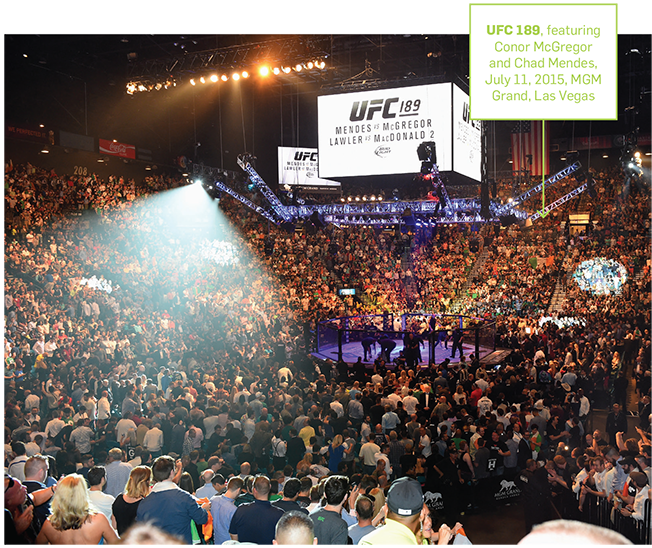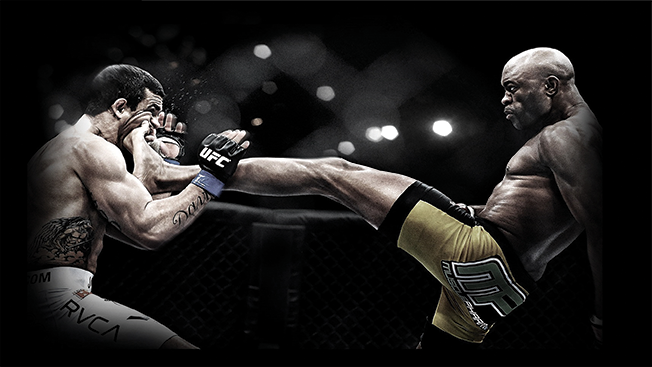The mixed martial arts franchise Ultimate Fighting Championship has never been in such fighting form. Since it was founded in 1993, it has become an established part of the sports mainstream (it's now bigger than baseball), as adrenaline-hungry fans around the world have flocked to its signature blend of violence, athleticism and entertainment. Its purchase this past July by powerhouse Hollywood talent agency WME | IMG for $4 billion only supercharged its winning streak.
With a global fan base of 269 million, brand partners in Anheuser-Busch InBev and Harley-Davidson, and superstars like Conor McGregor and Ronda Rousey, there has been but one bump in the path of UFC's ascendancy: New York. In a twist on the famous line about the city, UFC had made it everywhere—except in the country's biggest market where the sport had been banned.
All that's about to change.
In March, state lawmakers voted to legalize MMA in the state, giving UFC entree to New York's lucrative advertising market and access to one of the hottest venues in sports, Madison Square Garden, where the UFC will host its first New York fight on Nov. 12. New York was, in fact, the last holdout—UFC now has a presence in all 50 states.
"My compliments to the state of New York—welcome to the 21st century, and better late to the party than never," says Dino Bernacchi, U.S. marketing director for Harley-Davidson, which has been a UFC sponsor since 2007. "It's a big deal and an incredible market for us, and it can unlock more opportunities to get the brand out there."
To UFC president Dana White, who was recognized in 2014 as an Adweek Brand Genius for his work in building the franchise, entering New York is huge for UFC. "It's the media capital of the world, so it's very important," he says. "Our presence in New York creates a lot more awareness for agencies and brands."
The New York decision further legitimizes UFC, which has battled with regulators throughout its history as MMA is more difficult to regulate than traditional team sports, notes Matt Powell, sports analyst at NPD Group. "New York state coming in was a stamp of approval that they have their act together and it's a clean sport," he says. "It's a very meaningful decision for them [and] certainly getting a lot of attention, and brands are figuring out how to leverage it."

"Many people within the sport looked at New York as the pantheon of the fight world—so many of the great fights in history happened in New York, and all of the big leagues are headquartered there," adds Kelsey Philpott, senior director of global sports and entertainment consulting at GMR Marketing.
UFC has built itself up as a multifaceted entertainment powerhouse for thrill-seeking fans. It's a major draw for Las Vegas gambling, has spawned a chain of 135 gyms around the world and last year brought in $600 million in revenue. It reaches 1.1 billion TV households worldwide via broadcasts on Fox and Fox Sports 1 in the U.S. and by way of pay-per-view in 156 countries. Its fights are, in fact, the world's largest pay-per-view events, producing 42 telecasts every year. UFC pulls in more total fans than Major League Baseball (223 million) and the National Hockey League (199 million), according to Nielsen.
"If you look at where it was 15 or 16 years ago, UFC has come a long way," White says. "We're on network TV now, and women compete in the sport. It's more mainstream, and it reaches more people than you realize. It's obviously a combat sport, but golf isn't for everyone either. It's a tough sport, one that brands like Harley-Davidson want to associate with."

'Rebellious spirit'
It is precisely that aggressive attitude, along with its young fan base, that makes UFC an attractive partner for brands like Harley-Davidson. The median age of the UFC fan is 37.8. Forty-five percent of its fans are millennials (age 18 to 34), and 31 percent are male millennials.
Echoing White, Bernacchi of Harley-Davidson adds: "UFC has a rebellious spirit and is extremely competitive, and those are the exact characteristics of our brand. It's not for everyone, but it's definitely right for the audiences we're going after."
Harley-Davidson's promotions with UFC include "Hometown Throwdown," which had fans voting for cities where they wanted UFC to host events, and "The Ultimate Fighter Sweepstakes," which gave two fans the chance to win a motorcycle and to walk out with UFC fighters at an event. Harley-Davidson also hosts UFC viewing parties at its dealerships, its motorcycles are given as prizes at UFC fights and fights are occasionally led by motorcycle rallies.
It is a natural relationship. UFC stars like Michael Chiesa, Donald "Cowboy" Cerrone, Paige VanZant and Daniel Cormier are cycling enthusiasts and often post Harley-related content on their social media accounts. (One contest had a fan winning a motorcycle and riding lessons from Cormier and VanZant.) "We have UFC representatives who aren't just riding Harleys, but they're part of this brand," says Bernacchi. "Fourteen percent of their fan base have become riders [because of the partnership], and that number was more like four 10 years ago," he adds. "The activation and participation we get from their fan base whenever we do these promos is in the hundreds of thousands."

A global knockout
Most of the UFC's fan base is outside the U.S., with just 16 percent (42.2 million) of its fans here. That's key for Anheuser-Busch InBev, which has partnered with UFC since 2008 and relies on its relationship with the organization to promote Bud Light in the U.S., Canada and Mexico, and Budweiser in other markets. Activations include UFC-themed Bud Light packaging in the U.S., Bud Light ads in Canada featuring McGregor and Rousey, and Bud ads in Brazil with fighter Anderson "The Spider" Silva.
"UFC has been growing its audience all over the world, and it continues to grow, even in Asia and pockets of South America," notes Ricardo Dias, vp, global consumer connections at AB InBev. "It allows us to tap into a type of activation that would be difficult to have with a different sports league."
Working with UFC also gives brand marketers more bang for their buck when compared with America's other favorite contact sport: football.
"Compared to UFC, the cost of doing a deal with the [National Football League] is exorbitant," Philpott says. "For what brands pay to work with the NFL, they pay less than 10 percent of that to work with the UFC. They're certainly not hitting the same size, but they're hitting roughly the same demographic.
Going Hollywood
WME | IMG's acquisition of UFC further solidified its presence in the entertainment world. Appearances by UFC stars in movies and TV shows earn more exposure for the brand. VanZant and retired star Chuck Liddell have appeared on Dancing With the Stars—with an audience that's more soccer mom than millennials. Rousey, in particular, has been a huge hit with women, appearing in the Entourage movie and Furious 7 and hosting Saturday Night Live.
"Women got into the UFC because of Ronda Rousey," White says. "She opened up the sport for women and created a ton of female fans for the UFC, and it attracted more fighters. WME | IMG brings a lot to the table as far as our athletes doing more in entertainment, in Hollywood, movies and being on TV other than on a fight."
Still, UFC has some work to do when it comes to filling its pipeline with stars, Philpott says. Rousey, for instance, hasn't fought since being knocked out by rival Holly Holm last November, though she's predicted to return later this year. "There's a very small percentage of fighters in the UFC who are responsible for an overwhelming majority of its revenue," Philpott says. Events featuring McGregor and Rousey take in three or four times the amount of any other fighter. "WME | IMG needs to put all of their savvy behind building stars that can drive pay-per-view and live gate [revenue]," he adds. "And they need to refresh every three or four years. Because of the sport, the athletes always get beat down."
White is up to the challenge. "Nobody's better than finding talent and cultivating talent, in all different weight divisions," he says. "We're going to continue to do that, put on great fights, think outside of the box and do things that other sports wouldn't do."
The league will continue to expand globally, White believes, because of fighting's universality. "The difference between us and the NFL is, we're global, and we'll continue to grow globally faster than they ever will," he says. "Cricket is massive in England and India, but it's never going to catch on in the U.S. because we don't understand the rules. Fighting works everywhere—the rules don't have to be explained. I don't care what country you come from or what language you speak, for most human beings, fighting is in their DNA and they love it."
That fighting spirit is something UFC will certainly be able to count on in New Yorkers.

This story first appeared in the September 26, 2016 issue of Adweek magazine.








